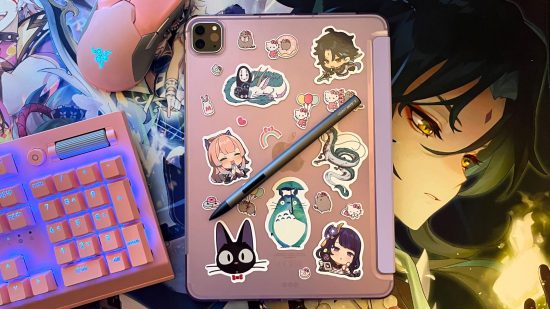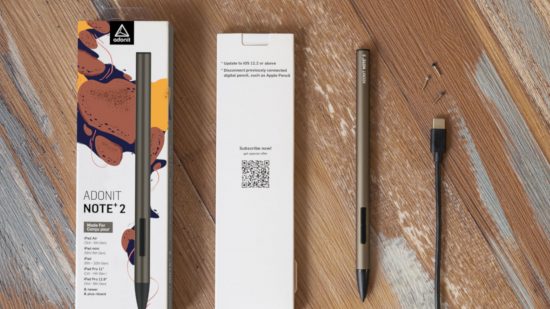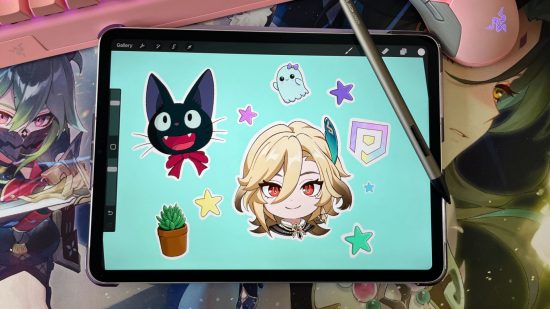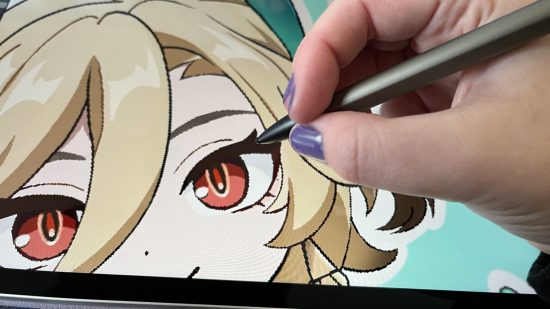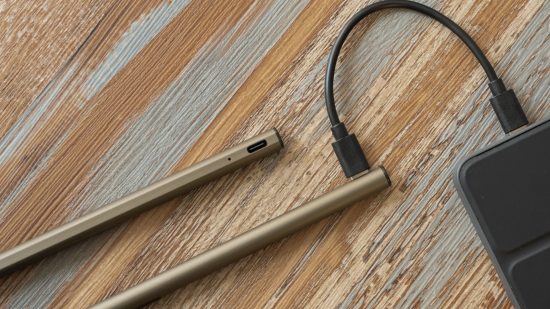Our Verdict
A solid stylus that offers a range of desirable features including pressure sensitivity, natural tilt support, palm rejection, and programmable shortcuts, the Adonit Note+ 2 is a sleek piece of kit with a solid battery, suitable for both casual use and digital art. While its supported apps are limited and there are some kinks with connectivity, it’s a strong and affordable competitor for the Apple Pencil.
As a hobbyist digital artist, I’ve always found the idea of drawing on my iPad alluring, but have never been able to justify the hefty price tag attached to the Apple Pencil. Over the years, I’ve used a few different graphics tablets, including the Wacom screenless, a large, Huoin digital display pen tablet, and the one I use now – the Huion Kamvas Pro 12, which is my favorite screen pen tablet by far, even moreso than some of the more expensive options I’ve tried. However, drawing on these tablets keeps you tethered to your desk by a set of cables, and sometimes that just doesn’t suit the creative flow.
As such, being able to work on a piece of digital art anywhere in the house – be it in bed, in the conservatory, or on the sofa as my partner and I watch a movie, certainly has its appeal. So, naturally, when I got the opportunity to go hands-on with the Adonit Note+ 2, I jumped at the opportunity. I’ve heard much about the Adonit being strong competition for the Apple Pencil, while coming in at about half the price. But does it truly compare? Is it worthy of a slot on our list of the best stylus for iPad and iPhones? Well, that’s what I’m here to tell you in this Adonit Note+ 2 review.
Pros:
- Affordable alternative to the Apple Pencil
- Automatic connection
- Supports pressure sensitivity, tilt, and palm-rejection
- Programmable buttons
- Lightweight and magnetic
- Comes with three replacement nibs
- Good battery life
Cons:
- Limited range of apps that support all functions
- Can be finicky to connect with certain apps
- Still quite pricey
- Hard to get/expensive replacement tips
Price and availability
The Adonit Note+ 2 is available from the official Adonit website as well as through a variety of third-party stores such as Amazon. At MSRP, it comes in at $69.99, which is around half the price of the Apple Pencil 2nd Generation, making it an affordable competitor for artists on a budget. The only issue with the Adonit Note+ 2’s availability is that of its replacement tips, which I’ll touch on later.
Specs
| Dimensions | 165.7mm x 9.5mm |
| Weight | 14g |
| Charging time | One hour |
| Battery life (continuous use) | Eight hours |
| Material | Aluminum body, plastic tip |
| Charge type | USB-C |
| Features | Pressure sensitivity, natural tilt support, palm rejection, and customizable shortcuts |
Design
The Adonit Note+2 comes in a sleek box from which the inner packaging slips out of the top, revealing a cardboard inner sleeve containing the stylus, three replacement nibs (in soft, medium, and hard – we’ll get to those later), and a short USB-C to USB-C cable for charging. There’s also a little user manual, which goes over the basic features of the pen, how to charge and turn it on, and how to connect it to your iPad, as well as a QR code for the Adonit app (not required for your pen to work).
While small and unassuming, the packaging is good quality, with a stiff foam interior that keeps the pen safe in transit. The USB-C cable is also of decent quality, though is only about five inches long, and with it being USB-C to USB-C, isn’t ideal for standard charging ports and plugs.
Onto the stylus itself. When picking it up, it’s immediately striking how light and comfortable it is. The Adonit Note+ 2 weighs in at an impressively light 14g, 1g lighter than its predecessor (the Adonit Note+), and a whopping 7.7g lighter than the Apple Pencil 2nd Gen. Some people prefer a weightier pen stylus, but I find this light weight much more comfortable, and it certainly prevents me from feeling fatigued after too long.
Its body is made of a lightly textured gray aluminum that makes it feel like a good quality writing pen without the weight, and it’s surprisingly slim and sits comfortably in your hand as a normal pencil would – this is vastly different from what I’m used to with graphics tablet pens, which are usually much thicker. It has a thin, flat magnetic edge on the back, along with the USB-C port near the top and two programmable buttons at the other end. Beyond the small white text that states its name, it’s very sleek and subtle in design – it’d be easy to mistake this for a graphite or mechanical pencil at a glance.
The two buttons are quite close to where most people would naturally place their thumbs and fingers, which may lead to some accidental button pushing while drawing, but their position also makes it easy to comfortably click them while working. The nibs feel pretty secure but are also easy to remove and replace, granted that you have any semblance of a thumb- or fingernail – just catch it under the edge and give a gentle pull, then slip it out and put the new one in.
Unlike its predecessor, the Adonit Note+ 2 actually comes with four tips – one hard one (already in the pen), then a pack of three in hard, medium, and soft. It’s a good thing it came with these extra tips, too, as within a week of light use the first tip snapped off. I’m not sure how it happened if I’m honest – the pen was attached to my iPad case, sitting on its own shelf in the storage trolley next to my desk. It may have gotten caught on something while I was cleaning, so it could very well be my fault. However, it’s certainly something to keep in mind, as, like many other styli, it doesn’t come with a lid or case, with the intent being that you connect it to your iPad via the magnet and you’re ready to go.
This appears to be a pretty common issue with pen styli, though – a cursory search brought up multiple people asking for advice after discovering the tip had snapped off their S-pen, Wacom stylus, and others. However, as the connector on the Adonit Note+ tip is metal, the tried and true hot needle trick doesn’t work here. Instead, you need some very fine-nosed tweezers, a steady hand, and a bit of patience. Luckily, I managed to pull the small metal rod out after a few minutes and replace it with a new tip, so it wasn’t the end of the world.
On the topic of tips, beyond the ones you get with the pen, it looks to be quite tricky to get replacements. At the time of writing, there’s no way of getting another pack of the Adonit Note+ 2 tips that come with the stylus. There’s a pack of three Adonit Note+ tips available on the official Adonit website for $15, but they’re all the hard version, and I can’t seem to find the soft or medium tips. Additionally, as Adonit is located in the US, shipping can be expensive overseas, and I’ve found little luck in locating them on other sites. There’s a listing on Amazon that ships to the UK for free, but they’re more expensive than if you were to buy them from Adonit directly (likely making up for import/shipping fees) and they take quite some time to get to you.
Now, if you’re a light sketcher or only using the stylus passively (and you don’t have a magical snapping nib situation like I did), this may not be an issue for you. I can’t say that I’ve had the Adonit Note+ 2 long enough to know how long one nib will last me, but I do draw with a light touch, and have personally never needed to replace the nibs on the pens from my graphics tablets, so I’m hoping these little beauties will last me a while. But, if you’re a bit more heavy-handed or intend on using the stylus a lot, or if you’re using one of those ‘paper feel’ screen protectors that are well-known for devouring stylus tips, these replacements could end up being a pretty pricey cost sink over time.
Features
As mentioned above, the Adonit Note+ 2 comes with two programmable buttons that you can edit to suit your needs in different apps. It also has pressure and tilt support, as well as palm rejection, so you don’t need to wear the dreaded ‘hand thong’ that most graphics tablet artists are so familiar with.
However, while you can pick up and use the stylus with just about anything on your iPad, there are a limited range of apps that fully support these appealing features. Adonit has a list of ‘Jot-ready’ supported apps that work with the Adonit’s shortcuts, palm rejection, pressure sensitivity, and/or palm rejection, but the list is quite small, and a lot of them are either premium or require a subscription to make full use.
When it comes to the PC, my favorite art app is easily Clip Studio Paint, which I’ve been using for a few years now. Any digital artist will know that changing apps almost feels like learning an entirely new language. I also found that several of the apps (specifically Illustrator Draw and Photoshop Sketch) aren’t available in my region (United Kingdom), which cuts the list down even further. I tried out several of the supported apps, even purchasing an Artstudio Pro subscription so I could use more than two layers and save my sketches, and while it took me some time to adjust to the different tools, there are certainly some gems in there – though it entirely relies on your art style and personal preferences.
But, if you’ve been in the online art space for any amount of time, you know that the most beloved and highly rated app is easily Procreate. Unfortunately, Procreate doesn’t support pressure sensitivity with any styli outside of the Apple Pencil. Once again, as someone who predominantly uses a pen tablet, I was very disappointed by this initially – pressure sensitivity is a feature that I thought I couldn’t live without if I’m honest.
However, after doing some research, I saw that a lot of people don’t bother with pressure sensitivity in Procreate, stating that you don’t really need it. I was desperate to try out the app that so many of my favorite artists use, so I decided to slap down the cash and give it a try, pressure sensitivity be damned – and I’m so glad I did.
Honestly, outside of dedicated graphics tablets, pressure sensitivity isn’t quite there yet. Even in the apps that do support pressure sensitivity, I can’t say I’ve been able to notice much of a difference. Procreate, on the other hand, is designed to work with a fingertip, never mind a nice, $70 stylus. With a combination of the opacity and size bars on the side of the screen and the extensive settings for each brush, you can bend the app and the Adonit Note+ 2 to do just about anything you need, and, while there are certainly some artists that wouldn’t be able to live without pressure sensitivity, I realize now that it’s absolutely not a necessity for me to be able to make any type of art I want.
To make this even better, there’s also the natural tilt support. This was an entirely new feature to me, so I didn’t really understand just how handy it is. If you’re as unfamiliar as I was, the Adonit Note+ 2’s tilt support allows you to lean your pen at an angle and shade the same way you would with a pencil. In supported apps like Procreate, this results in a light, grainy shadowing effect that looks very natural. This, once again, lessens the sting of the lack of pressure sensitivity and has completely won me over.
Performance and connectivity
In terms of performance and connectivity, the Adonit Note+ 2 is quite impressive. Ensure your Bluetooth is switched on, press the button on the stylus, and away you go – no extra apps, calibration, or settings to mess with. It’s very responsive both in and out of art apps and is great for typing or simply browsing the internet. I’ve not had any issues with the standard level of connectivity, and my iPad Pro (11-inch) consistently reads all inputs with no problems.
The one place the connectivity struggles, though, is in the different art apps. All art apps have their own way of connecting to a stylus, be it the official Apple Pencil or a supported third-party option. And, while the Adonit Note+ 2 works at a basic level in every app from the get-go, in order to use its extra features such as the pressure sensitivity or tilt support, you need to connect it to each individual app.
In most of the supported apps, this requires you to go to the settings, select the third-party stylus option, then ensure the stylus is on and hold the tip to a specific part of the screen. In order to put the pen in pairing mode, it just requires one press of the button closest to the pen’s tip, which is nice and simple. However, sometimes apps continue to search, and you have to exit the app, turn the pen off, re-launch the app, and try again. It can also cause even more problems if you’re switching between art apps. For example, I had my Adonit Note+ 2 connected to Artstudio Pro, then switched to Medibang Paint. When I went back to Artstudio Pro, it wouldn’t recognize the stylus at all until I restarted the app.
I don’t think this is an issue with the Adonit Note+ 2 specifically, to be honest – this feels more like an issue with how the iPad and apps interact with third-party styli. Additionally, the switching apps scenario is certainly situational, and I’ve had no connectivity issues at all since I’ve changed to working entirely in Procreate – every time I launch the app and switch on my Adonit Note+ 2, it immediately recognizes it, without me even having to go through the connection process again. As such, I find it to be a very minor issue, though it may be worth keeping in mind when you’re first starting your Adonit Note+ 2 journey.
Battery life
On the Adonit website, the Adonit Note+ 2 claims to have an eight-hour continuous use battery life, with a one-hour charging time. I can’t attest to exact figures, but I’ve had no issues with battery life for my personal use. I’ve been using the stylus almost exclusively for art during lunch breaks and evenings, and find it lasts quite a while at full charge, and I only need to give it some more juice every couple of days. You can also still use the stylus while it’s connected to a charging cable, though the one provided by Adonit is a bit too short for that, and even with a longer wire, it feels quite unwieldy while tethered.
It also does charge quite quickly, and the addition of the LED light indicator is very handy. When the stylus battery is running low, the usual blue light turns red. It then stays red while charging until it has enough battery, and turns blue again when it’s ready to go. It’s a simple feature, but I do appreciate it, considering the fact that I’ve yet to find a way to see the stylus’ battery life on my iPad.
Verdict
Overall, I’m very happy with my Adonit Note+ 2. It’s a very impressive little stylus for a far more affordable price than the Apple Pencil, and it allows you the freedom to start sketching whenever creativity strikes, regardless of where you are.
Its range of handy features, reliable performance, and steady connectivity make it easy to pick up and go in most situations, and its slim, lightweight design and solid battery life make it perfect for long periods of use.
While its range of supported apps is limited, it’s hard to find another third-party stylus that offers so much bang for your buck. I only hope that the Adonit Note+ 2 tips become more readily available in the future and that more apps work on supporting styli other than the Apple Pencil. But, for now, I’m very satisfied with this piece of kit and can see myself using it consistently – perhaps even more than my graphics tablet – for the foreseeable future.
Alternatives
Don’t think the Adonit Note+ 2 is the stylus for you? That’s okay, there are several alternates out there.
Apple Pencil (2nd Generation)
When it comes to styli for the iPad or other Apple devices, nothing is truly going to beat the Apple Pencil. Unlike third-party options, you can rest assured that most apps will support all of the Apple Pencil’s features, including tilt and pressure sensitivity, pixel-perfect precision, the option to double-tap to change tools, and more. It also supports wireless pairing and charging, boasts industry-leading low latency, and seamless connectivity. If you can warrant dishing out the extra cash, it’s well worth it.
Samsung Galaxy S Pen Pro
Not an Apple fan? No problem. The Galaxy S-Pen is a perfect choice for Android users, offering all those sought-after features like pressure sensitivity, natural tilt support, and more. With the tagline of ‘the pen nature intended’, the S-Pen Pro aims to feel as close to a real pen as possible, with the added bonus of being able to magnify, navigate, and create a full palette of brush and pen types. Some reports state that the S-Pen’s durability can be a little lacking, but overall, it’s considered the main competitor for the Apple Pencil when it comes to the Android world.
Right, it’s time for our Adonit Note+ 2 review to draw to a close – and for me to get back to sketching the night through. If you’re on the hunt for even tech, take a look at our list of the best gaming phones or the best gaming iPhones. We’ve also got a list of the best iPad games if you need a break from doodling.
